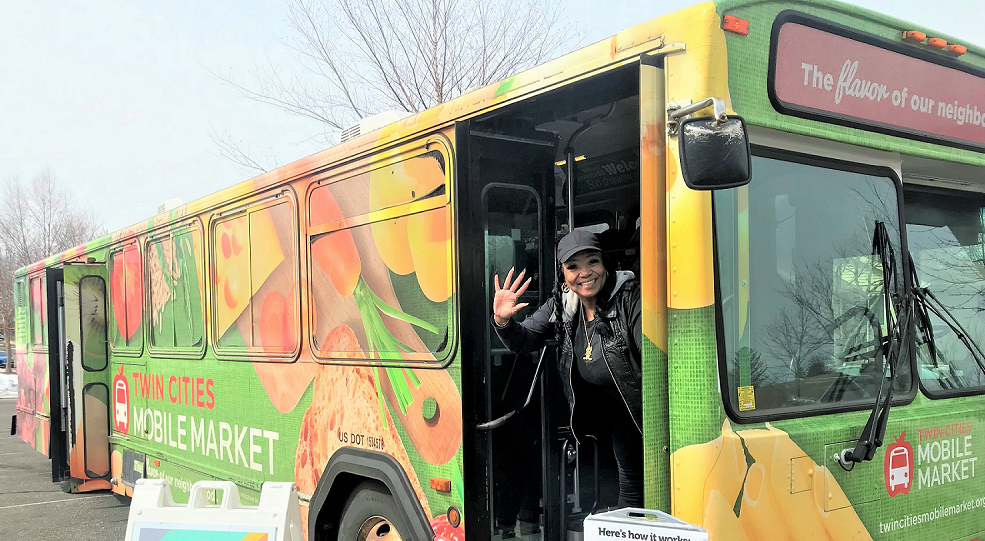For people who live in neighborhoods where supermarkets are scarce, finding food is often more problematic than having money for food.
A growing number of food banks are addressing this issue by moving into a new model of food banking. In addition to distributing free food via pantries, they are making grocery-store style shopping available – an approach that requires food banks to charge at least modest fees to clients.
While free food will always have a role to play in charitable food distribution, low-cost groceries are emerging as a way to address an increasingly common segment of people – those who have some income for food, but no convenient way to shop for it.
“Free food is critical and it’s an important safety, but we need to look at the retail landscape too,” said Sophia Lenarz-Coy, Executive Director at The Food Group, referring to the tendency of supermarkets to be located mostly in wealthier areas. “For us, it’s just been really important to think about both models, not remotely in competition with one another, but as responding to the needs that households have.”
Among food banks, Minn.-based The Food Group may be a pioneer in low-cost groceries, having gotten involved in 2001, when it got behind a pop-up grocery that sells fresh produce and frozen meat at up to 40% off retail prices. Operating from a truck that makes the rounds monthly at 30 or so sites, such as churches and community centers, the Fare for All program serves 50 to 75 people at each site during a two-hour window.
Fare for All is able to offer deeply discounted food by purchasing in bulk from wholesalers, manufacturers and growers. The no-frills, low-tech program lets customers choose from a few options, such as a $25 meat pack or a $10 produce pack, with no pre-ordering or a la carte shopping. “You just show up,” Lenarz-Coy said. “It’s very simple.”
An important aspect of the program is that it is open to anyone regardless of income. Not only does that increase the food bank’s purchasing power, but it reduces stigma by attracting folks who happen to be coupon clippers in search of great deals. Lenarz-Coy suspects the program attracts people who might qualify to use a food pantry, but don’t see themselves as fitting into that category.
More recently, The Food Group has added a second affordable grocery option, the Twin Cities Mobile Market, which functions like a grocery store on a bus. Particularly suited for low-income people in urban areas, especially seniors in public housing, the mobile market offers a wide range of groceries at prices of up to 30% less.
The 30% discount though, is a goal, not a hard and fast rule. “What we hear from customers is that even more than price, what they’re looking for is the access,” Lenarz-Coy said. In that respect, the mobile market differs greatly from Fare for All, where affordability is key and a limited selection is the expectation.
Other differences: the mobile market is a much smaller program, serving just over 2,300 people through May of this year, versus Fare for All’s 10,500. Transaction sizes are also much lower, given that the market serves low-income seniors on very limited grocery budgets. And while Fare for All has the potential to be a self-sustaining operation, the mobile market is decidedly grant-dependent. “It’s sustainable through the lens that funders really want to support it,” Lenarz-Coy said.
The backdrop to both these programs is The Food Group’s network of more than 200 partners, which make up the bulk of the food bank’s distribution. Lenarz-Coy recognizes that some food banks may see charging for food as out of step with the mission of charitable food. She sees it as “a totally different program area. We have our food pantry network, we also have our affordable grocery work, where we’re sourcing differently and thinking differently about revenue streams.”
At Feeding Tampa Bay, affordable groceries are integral to its healthcare outreach. Its Groceries on the Go mobile pantry serves as an outpost where patients of Feeding Tampa Bay’s healthcare partners can get their healthy-food prescriptions filled at a discount. While patients might get their initial prescription filled at the medical facility, most will find it more convenient to spend the rest of their prescription vouchers at a Groceries on the Go mobile pantry in their neighborhood. The pantry also accepts SNAP (the first mobile retailer in Florida to do so) and Fresh Access Bucks, which provide $10 of fresh produce for free.
The low-cost grocery approach enables Feeding Tampa Bay to offer the type of healthy food its healthcare partners are prescribing, such as fresh produce, lean proteins and whole grains, which would be difficult to provide via donated food only. The food bank currently has about seven different food prescription programs, all supported by grant funding, often from insurance companies interested in testing the impact of healthy food on health outcomes.
While Groceries on the Go generates a revenue stream, it is not a profitable endeavor. It is sustainable, however, given the grant funding that supports it, said Matt Spence, Chief Programs Officer. “Profitability is not necessarily our target,” he noted. “It’s more about access and agency.”
Dare to Care’s approach to low-cost groceries is unusual in that it runs its Zero Hunger Mobile Market in partnership with Kroger, which has a seat on the food bank’s board. Both entities were seeking to increase access to healthy food in underserved neighborhoods, and realized they could better reach that goal together, said Annette Ball, Chief Programs Officer at Louisville, KY-based Dare to Care.
Kroger takes care of everything inside the tractor-trailer turned single-aisle grocery, including the food, shelving, refrigeration, and point-of-sale cashier system. Dare to Care handles everything outside the trailer, such as truck maintenance and gas. “It works out well for us in that we don’t have to have the inventory and we can have a really robust offering to give to the community,” Ball said.
The market offers about 500 food items, up from about 200 when it started in 2019. Customers (who are mostly senior citizens) get 10% off the lowest price available. The wide variety ensures choice and dignity, Ball said. “Bringing the food to them allows them to be able to make that choice and get things they feel they want.” Dare to Care’s free mobile pantry, in contrast, has a much more limited inventory, offering maybe ten products at a time.
Kroger provides two staffers for the Zero Hunger Mobile Market – one who runs the cash register and one who does customer service, including replenishing inventory when necessary. Dare to Care provides the truck driver. “If we were having to staff three staff members, it would be a lot more complicated,” Ball said. “A lot more fundraising would have to happen.”
Capital Area Food Bank sees low-cost groceries as “just one more piece of the spectrum of food access,” said Hilary Salmon, Senior Director of Marketing and Communications. Its Curbside Groceries program came about when the D.C.-based food bank did a survey of about 2,000 clients and found that many of them have some funds for groceries, but are limited by a lack of access and transportation. “They want to buy groceries if they can do it affordably and at locations that are easily accessible,” Salmon said.
While the immediate goal of Curbside Groceries is to improve access to food, a longer term goal is to show that demand for healthy groceries exists in underserved neighborhoods. Capital Area currently has two trucks making 14 stops per week, and is hoping to increase that to 24 a week.
If it can prove the concept, it is hoping to attract an existing retailer or even an entrepreneur to pick up the idea of an alternative format for groceries and bring it to market. That’s part of the reason why Curbside Groceries is branded as its own entity, apart from the food bank. Noted Salmon, “We want to show that there is demand because we’ve heard it from our clients.” – Chris Costanzo
CAPTION FOR PHOTO ABOVE: The Food Group’s Twin Cities Mobile Market functions like a grocery store on a bus.
Like what you’re reading?
Support Food Bank News
This article was made possible by the readers who support Food Bank News, a national, editorially independent, nonprofit media organization. Food Bank News is not funded by any government agencies, nor is it part of a larger association or corporation. Your support helps ensure our continued solutions-oriented coverage of best practices in hunger relief. Thank you!
Connect with Us:










